Five of the best sento bathhouse experiences in Tokyo
This article is part of a guide to Tokyo from FT Globetrotter
Whenever I’m hungover, tired, stressed, sweaty after a run or just want to relax, I head to my nearest public bathhouse, or sento, to get naked with the locals and soak in the hot tubs. No matter how I feel before bathing, I feel rejuvenated afterwards.
Every one of Tokyo’s 500 or so sento offers a unique atmosphere, and varying combinations of bathing experiences. They range from simple hot-water baths (careful, some are scalding) to micro-bubble and herb-infused tubs, and in some places the daunting denki buro, in which a low-level electric current surges through your body. But the most invigorating for me is the mizu buro, a bath often cooled to under 15C that snaps you out of a post-soak or sauna haze and readies you for another dip in the hot tub.
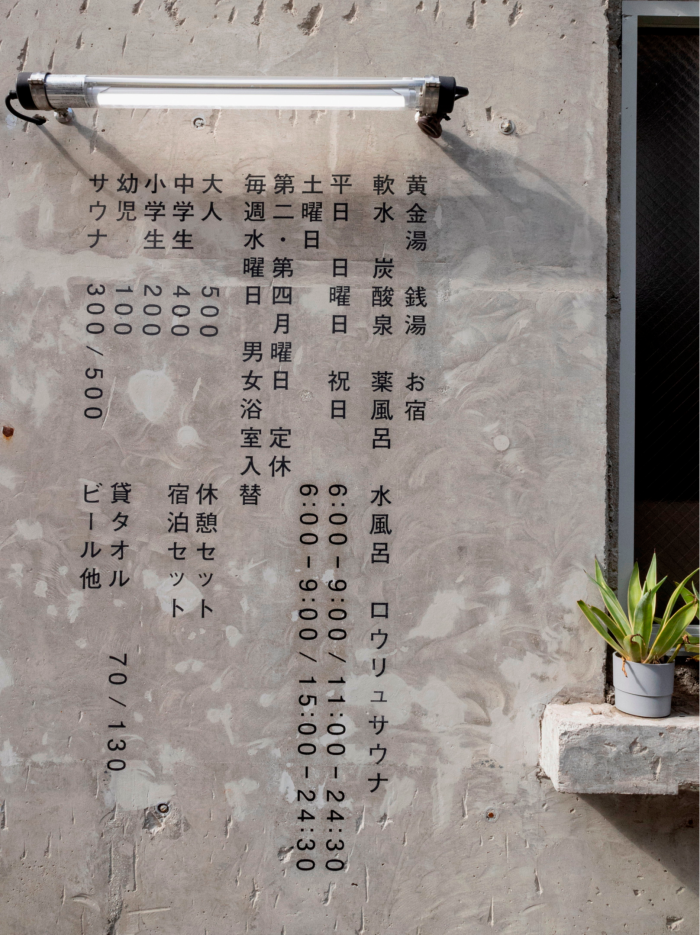 At the more designer end of the sento spectrum sit Kogane-yu . . .
At the more designer end of the sento spectrum sit Kogane-yu . . .
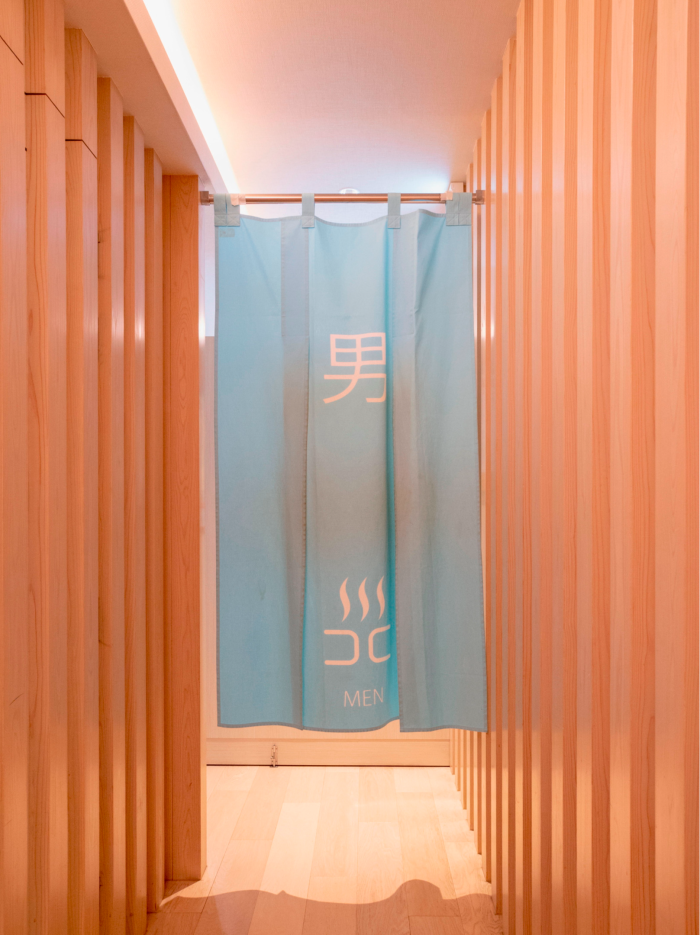 . . . and the sleek Kohmeisen, in the hip Nakameguro neighbourhood
. . . and the sleek Kohmeisen, in the hip Nakameguro neighbourhood
The ritual for any sento is basically the same. After paying ¥500 (about £3) at the front desk — a flat fee for all bathhouses in the capital — and a few hundred yen extra for a sauna, men and women file through a noren curtain into their respective changing rooms. All sento in Tokyo are strictly partitioned by gender.
The sento is a great leveller, as everyone has equal status when stripped down to their birthday suit. People are courteous and make space for others with short nods. The bathers range from grandfathers to infants, from business executives to convenience-store workers, and from priests to gangsters. I once sat in a sauna next to a man with full-body tattoos reading a yakuza gossip magazine.
Once changed, you can relax with a cold drink (often flavoured milk or a beer) in a common room with a TV showing the news or the latest Tokyo Yomiuri Giants baseball game. Some pay ¥100 for the use of a massage chair.
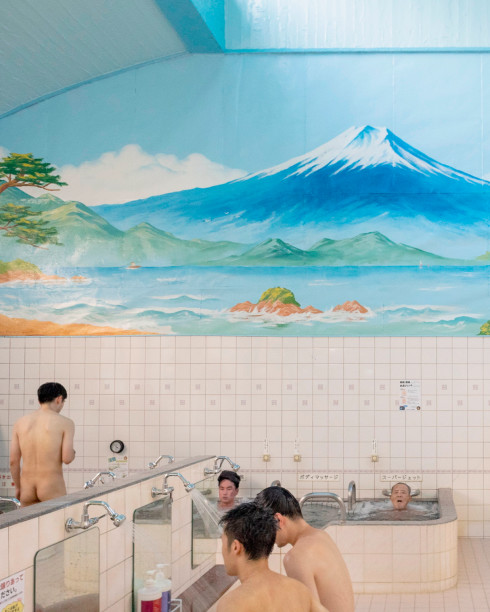 A mural of Mount Fuji — such as this one at the resolutely retro Daikoku-yu — is almost obligatory in a sento
A mural of Mount Fuji — such as this one at the resolutely retro Daikoku-yu — is almost obligatory in a sentoCommunal bathing has been a custom in Japan for more than a millennium, originally in temples as part of a Buddhist cleansing ritual. Sento came to be a common sight in urban areas during the Edo period (1603-1867). But construction really started to boom in poorer areas of Tokyo after the 1923 earthquake, giving migrant workers a place to bathe after a day spent toiling to rebuild the capital. The bombing of Tokyo in the second world war also left many without baths or even homes, prompting another rush to build bathhouses. The number of registered sento in the country peaked at 17,999 but that has fallen to 1,865. The current surge in energy prices is increasing already expensive heating bills, forcing some places to reduce operating hours.
But sento culture remains strong. Many places have had facelifts in recent years to appeal to a younger, hip crowd, and serve as running stations where you can leave a change of clothes in a locker before heading out for a jog followed by a soak. And those steeped in history that try to maintain a community spirit continue to attract loyal bathers.
Lying just off the Nakasendo, one of the two road routes from Tokyo to Kyoto during the Edo Period, Inari-yu is for the traditionalist.
This no-frills sento with its temple-style architecture sits in a narrow street of a neighbourhood that feels little changed from more than a century ago. Established in 1914 and rebuilt in 1930 after the 1923 earthquake, Inari-yu was registered as a National Tangible Cultural Property in 2020.
No fancy baths here, just three tubs — one warm, one hot, one fit for boiling lobsters. A long painting of Mount Fuji glimmering behind an island-filled lake stretches between the divided male and female bathing areas. The cypress water buckets are another nod to sento heritage.
 Inari-yu’s mural of Mount Fuji
Inari-yu’s mural of Mount FujiInari-yu was used as the location for Thermae Romae, the Japanese movie adaptation of a manga about a struggling Roman-bathhouse architect who travels forward in time to find inspiration in a modern Japanese sento. A Netflix animation was released in March.
What Inari-yu had lacked was a communal area where people could relax with a post-soak drink. But that has changed thanks to Sento & Neighborhood, a non-profit led by American urban activist and writer Sam Holden that aims to preserve Japan’s public bathhouses. It recently refurbished an abandoned nagaya tenement next to the sento into a community space. Beer is on tap.
Kogane-yu
4-14-6 Taihei, Sumida-ku, Tokyo 130-0012
Good for: Fragrant, steamy sauna
Not so good for: Queues
FYI: It’s a very creative space
Website; Directions
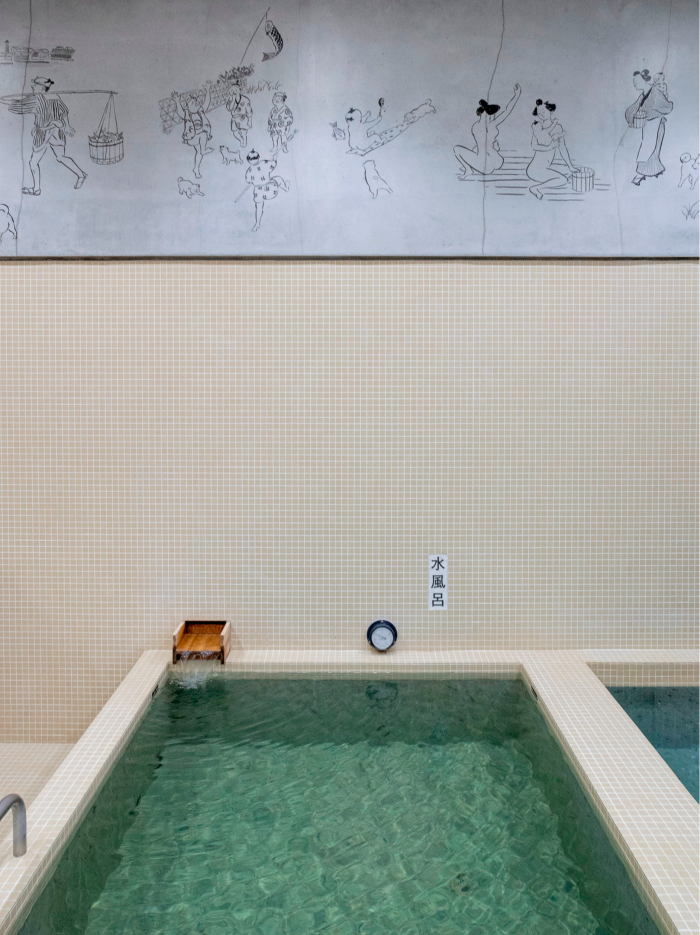 One of the baths at the popular 90-year-old Kogane-yu . . .
One of the baths at the popular 90-year-old Kogane-yu . . .
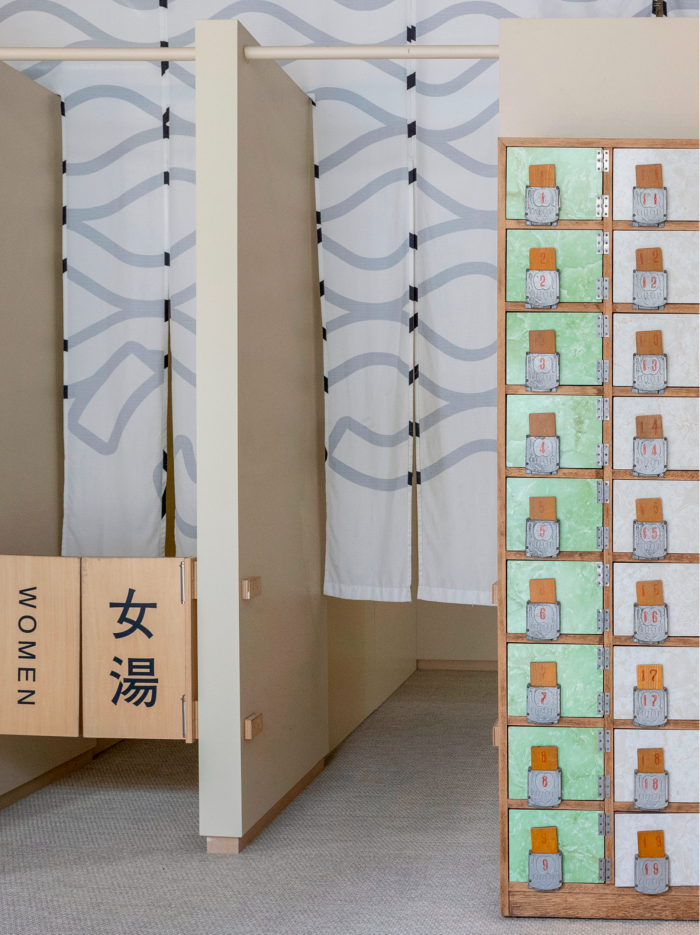 . . . which was recently restored after a crowdfunding appeal
. . . which was recently restored after a crowdfunding appeal
The rare reservation button on Kogane-yu’s website illustrates the popularity of this sento in the shadow of Tokyo’s landmark Skytree tower. You can book online a night in a spacious capsule-type hotel room, a body scrub or a slot in the sauna — advisable, as about half a dozen people were waiting outside for a berth when I visited recently.
It was facing closure at the start of the pandemic, so the owners turned to crowdfunding to renovate the 90-year-old site. They got in architect Jo Nagasaka to lead the facelift, which now includes a craft beer bar with DJ decks to boot. The creative flourishes are overseen by contemporary artist Hiroko Takahashi, and manga artist Yoriko Hoshi painted the traditional mural of historic bucolic scenes inside the bathhouse.
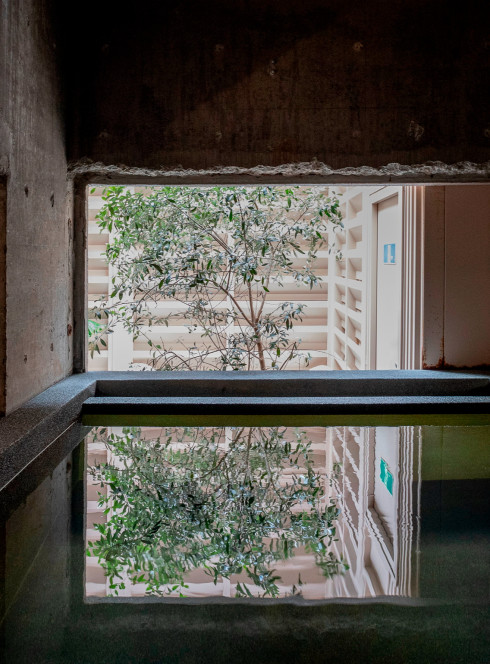 The cold bath at Kogane-yu
The cold bath at Kogane-yuThe bathing area is relatively small, but has four pristine baths: hot, herbal, carbonated and cold. If you booked or are lucky enough to avoid a queue, the sauna area that lies to the back is the real gem of Kogane-yu. The benches are decked in fragrant, domestically produced hiba wood, and the maifan-stone-clad walls raise the humidity for a steamy perspiratory experience. The large tub next to the sweat-room is cooled to 15C, and the outside seats are made for snoozing.
Once refreshed, it’s time for a rehydrating glass of one of the sento’s original craft beers to a soundtrack of some choice cuts. Non-alcoholic beverages are available too.
Kohmeisen
1-6-1 Kamimeguro, Meguro-ku, Tokyo 153-0051
Good for: Its outside bath
Not so good for: Crowded on weekends
FYI: It’s in the heart of the hip Nakameguro district
Website; Directions
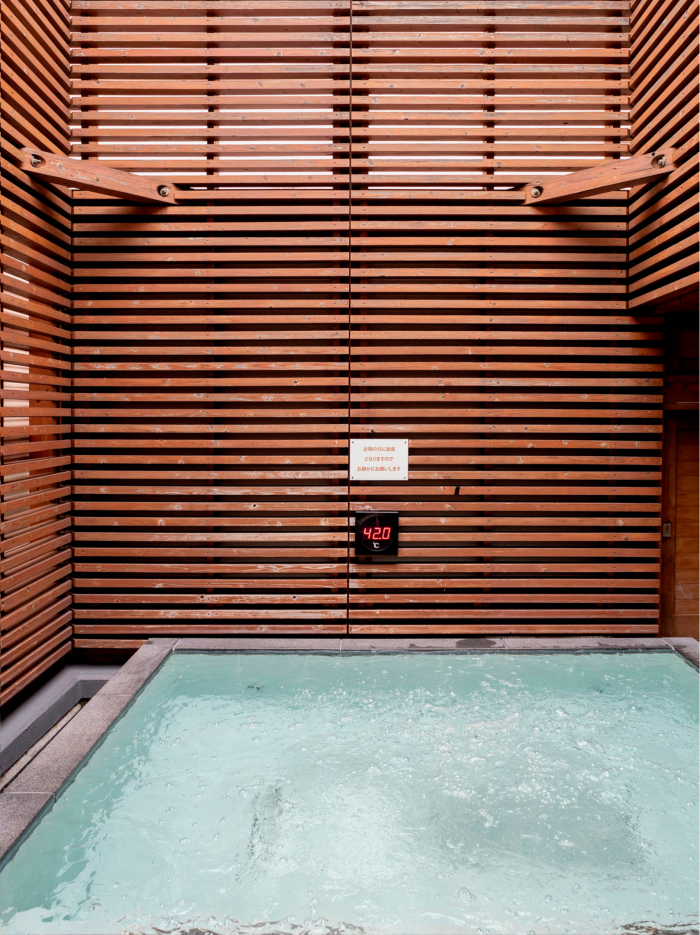 The outdoor bath on the roof of Kohmeisen is surrounded by a tall wooden structure
The outdoor bath on the roof of Kohmeisen is surrounded by a tall wooden structure
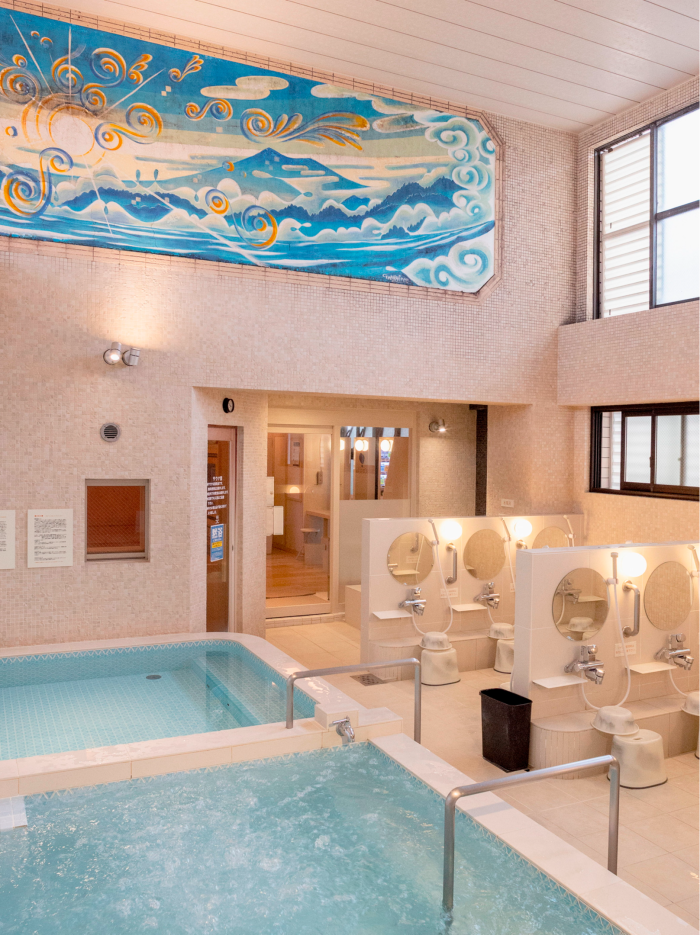 Kohmeisen’s main bathing area
Kohmeisen’s main bathing area
On a side street in the boutique-rich suburb of Nakameguro, a climb up a flight of stairs takes you into the small oasis of calm that is the Kohmeisen sento. A family-run business for three generations, this bathhouse was refurbished in 2014 in a tasteful style that reflects the area around it.
Up another set of stairs is a terrace with an outside bath. Protected from prying eyes by a tall wooden structure that allows bathers to look up at the sky, this rotenburo (open-air bath) is a unique experience. The tranquillity of a soak in the crystal-clear pool is broken every few minutes by the gentle thud of a train passing by just metres away. The weather is not an issue (a day before my recent visit, the terrace stayed open during a typhoon — something this writer wants to experience).
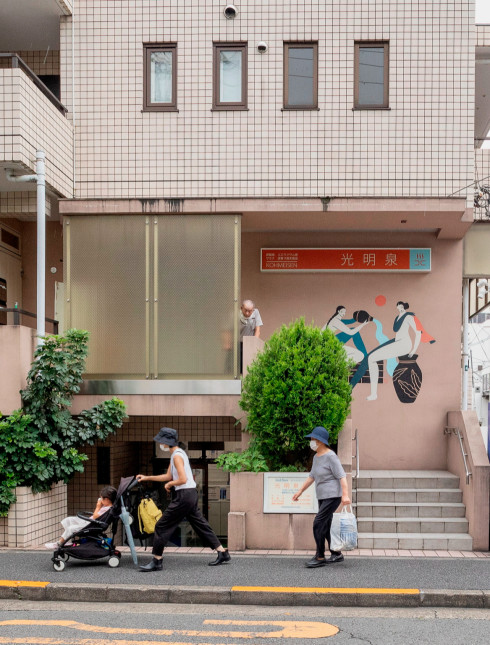 Kohmeisen is located on a side street in Nakameguro
Kohmeisen is located on a side street in Nakameguro Those who wish to use the sauna have to be either patient or avoid weekends. The craze in Japan among young people for steam rooms meant a queue for the hammam snaked around the bathhouse.
The small reception area doesn’t have space for a post-soak refreshment, but the myriad restaurants and cafés nearby mean you don’t have to look far to rehydrate.
Daikoku-yu
3-12-14 Yokokawa, Sumida-ku, Tokyo 130-0003
Good for: Rest area with a hammock
Not so good for: The cold bath is very small
FYI: Open through the night until 10am
Website; Directions
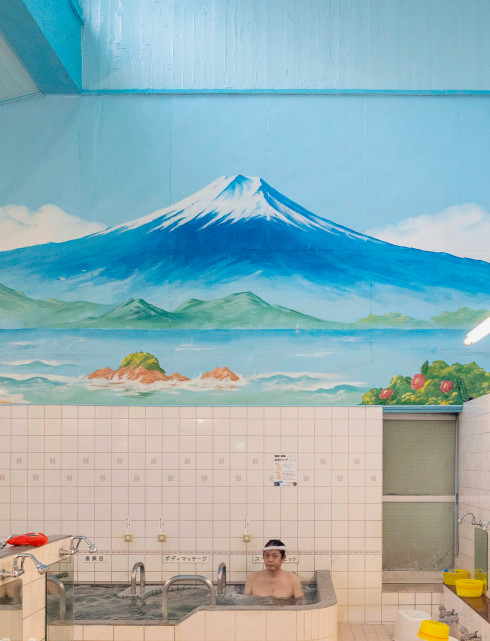 The emphasis at Daikoku-yu is on tradition
The emphasis at Daikoku-yu is on traditionDaikoku-yu is the retro sibling of the swanky Kogane-yu, just a few minutes’ walk away. The emphasis here is on tradition — there’s no craft beer or DJs, just the usual milk drinks and the echoing sound of running water.
The bathing experience is probably better than its more illustrious neighbour. It’s not crowded, there is a lot more space to enjoy a good soak and there are no queues for the sauna (which houses a small TV fixed to a commercial channel showing dramas and gossip shows).
This sento has a range of tubs: three types of Jacuzzi, a herbal bath and a micro-bubble bath that leaves your skin silky-smooth. Depending on the day (the owners swap the men’s and women’s area weekly), one side has a large rotenburo, while the other only has a cramped outside area.
The best part of my recent visit was climbing a staircase with a beautiful hinoki (Japanese cypress) fragrance to an outdoor relaxation area. Lying down in a hammock, I looked up at clear blue skies and the top of the nearby Skytree tower before being swayed into a lovely nap.
Tell us about your favourite Tokyo sento in the comments
Follow FT Globetrotter on Instagram at @FTGlobetrotter
Cities with the FT
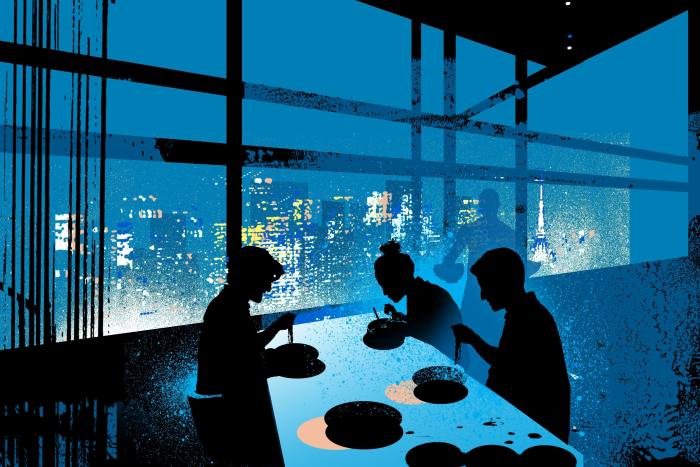
FT Globetrotter, our insider guides to some of the world’s greatest cities, offers expert advice on eating and drinking, exercise, art and culture — and much more
Find us in Tokyo, New York, London, Paris, Rome, Frankfurt, Singapore, Hong Kong, Toronto and Miami
This story originally appeared on: Financial Times - Author:Andrew Sharp










